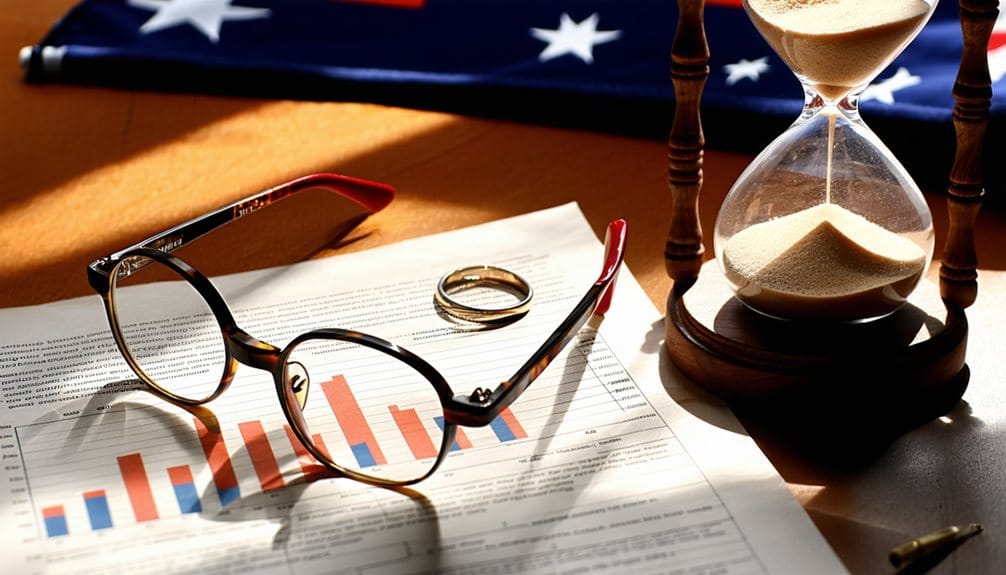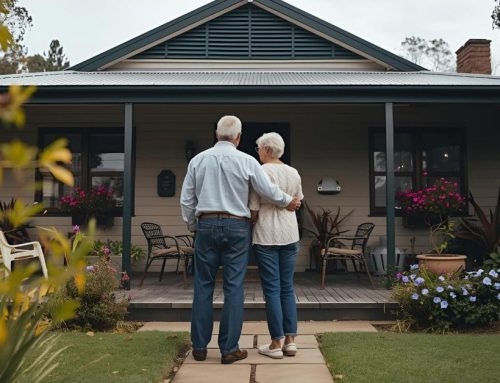Estate planning is about more than wills and inheritance. A binding financial agreement (BFA) can act as a planning [...]
Think about Australia’s divorce rate, which in 2022 was 2.4 per 1,000 residents. This statistic tells a story when you consider that the average marriage lasts 12.8 years.
How do these figures stack up against marriage rates? And what about the differences across states like Queensland and New South Wales where divorces happen most frequently?
With around 30% of marriages expected to end, it’s like peeling an onion—there are layers of complexity, especially considering the recent pandemic’s impact.
Ever wondered about these patterns and what they mean? Let’s dig into these fascinating insights and see what they reveal.
What Are the Key Statistics on the Divorce Rate in Australia?

You’re probably curious about how the divorce rate in Australia has changed over recent years. The Australian Bureau of Statistics reports a return to pre-COVID levels with 2.4 divorces per 1,000 residents in 2022. Regional variations are notable, with New South Wales leading in numbers, followed closely by Victoria, offering a glimpse into the differing dynamics across states.
How Has the Divorce Rate Changed Over Recent Years?
In recent years, you’ve probably noticed a shift in the divorce landscape in Australia, marked by a subtle decline in the divorce rate. The number of divorces granted decreased, with a 2022 crude rate of 2.4. Marriages averaged 12.8 years in duration. The highest number of divorces occurred in New South Wales. Despite this, the impact on families remains significant, affecting thousands of children.
What Does the Australian Bureau of Statistics Report Say?
Australia’s divorce landscape reveals intriguing trends, as detailed by the Australian Bureau of Statistics. The crude divorce rate stood at 2.4 per 1,000 residents in 2022. This return to pre-COVID levels emphasises the impact of divorce on families:
- Number of divorces in 2022: 56,244, with New South Wales leading.
- Average marriage length: 12.8 years.
- Decline in divorces: Across all states.
How Do Divorce Statistics Vary by Region, Like South Australia and New South Wales?
When examining divorce statistics by region, you’ll notice significant variations, particularly between South Australia and New South Wales. New South Wales recorded the highest number of divorces granted at 14,661 in 2022. Meanwhile, South Australia experienced a notable decline, reflecting a broader trend as divorce rates are also decreasing nationwide. The crude divorce rate stands at 2.4 per 1,000 residents, showcasing regional differences.
How Do Marriage and Divorce Rates Compare?

You’ve probably noticed that Australia’s marriage rate has seen a significant rise, reaching 6.1 in 2022, reflecting a return to pre-pandemic levels. Yet, with about 30% of marriages ending in divorce, it raises the question of how these trends interact. Understanding whether the number of marriages influences the divorce rate can help you grasp the complex dynamics of relationships in modern Australia.
What Is the Current Marriage Rate in Australia?
In 2022, the marriage rate in Australia reached a notable high, with 127,161 marriages recorded, translating to a crude marriage rate of 6.1 per 1,000 people aged 16 or over. You’ll find fascinating marriage statistics illustrating:
- A significant rebound from 2020’s low point.
- A strong increase in marriages registered in New South Wales and Victoria.
- A contrasting divorce rate among residents at 2.4 per 1,000.
How Many Marriages End in Divorce?
Currently, about 30% of marriages in Australia end in divorce, highlighting a significant trend in relationship dissolution. The crude divorce rate stands at 2.4 per 1,000 residents. In 2021, the number of divorces granted was 56,244. Significantly, second marriages face a higher risk, with 60% ending in divorce. This percentage of marriages that end emphasises the complexities of maintaining long-term relationships today.
Is There a Correlation Between Total Marriages and the Divorce Rate?
Understanding how many marriages end in divorce provides a foundation for examining the correlation between total marriages and the divorce rate in Australia. Examining factors:
- Median age at marriage influences relationship longevity.
- The total number of divorces granted reflects trends, though marriages rise.
- Divorce rates may vary; second marriages experience the highest divorce rate.
These insights reveal complexities behind the marriage-divorce interplay.
What Is the Average Length of Marriage in Australia?

When considering divorce in Australia, you’ll find that the average length of marriages that end in divorce is around 12.8 years. This duration highlights a critical period where many couples may face life changes that influence their decision to separate. Understanding how the length of a marriage affects divorce rates can provide valuable insights into the dynamics that lead to marital breakdown.
What Is the Median Duration of Marriage Before Divorce?
In examining the typical journey of marriage in Australia, the average length before divorce stands at 12.8 years, suggesting that couples often spend over a decade together before deciding to part ways. This median marriage duration is a reflection of the complex dynamics captured in marriage and divorce statistics. Consider these points:
- Number of divorce applications reflects societal changes.
- Average length of marriages remains stable.
- Divorce rate remains significant.
How Does the Duration of Marriage Affect Divorce Rates?
Over the years, the duration of marriage has emerged as a significant factor influencing divorce rates in Australia. With the average length of marriages ending in divorce at 12.8 years, the likelihood of divorce increases as couples age. Remarkably, second marriages in Australia often face similar challenges. The median age at divorce, 46.7 for men and 43.7 for women, underscores this trend.
What Are the Trends for Second Marriages and Second Marriage Divorce Rates?

If you’re considering a second marriage in Australia, it’s important to understand how the divorce rates compare to first marriages. Second marriages have a higher divorce rate, with about 60% ending in separation. The median age at divorce for these marriages often reflects the added complexities and pressures of blending families and managing financial obligations from previous relationships.
What Is the Median Age at Divorce for Second Marriages?
Amid changing relationship dynamics, the median age at divorce for second marriages in Australia reveals intriguing insights. For men, it’s 46.7 years, while women face it at 43.7 years. This data reflects:
- A 60% divorce rate highlighting the fragile nature of second marriages.
- 10.8% of marriages being second marriages, indicating remarriage rates.
- Complexities from previous relationships affecting these unions.
Are Second Marriage Divorce Rates Higher Than First Marriages?
Second marriages in Australia face a stark reality, with divorce rates soaring to about 60%, double that of first marriages. Manoeuvring the complexities of blended families, unresolved emotional baggage, and financial pressures from previous unions contributes to this statistic. With 10.8% of marriages being second marriages, understanding these dynamics is essential. The statistics on divorce highlight the heightened challenges and instability second marriages encounter compared to first marriages.
How Has the COVID-19 Pandemic Affected Divorce in Australia?

You’re likely aware that the COVID-19 pandemic initially caused a spike in divorce applications in Australia. Family lawyers have noted that the stress and confinement during lockdowns led many couples to reassess their relationships. However, as life gradually returned to normal, the number of divorces decreased, suggesting some stabilisation in marital dynamics.
Did the COVID-19 Pandemic Lead to an Increase in Divorce Applications?
The COVID-19 pandemic, with its unprecedented stressors, indeed led to a temporary increase in divorce applications in Australia. Latest statistics show a spike in 2021, with the rate of divorce reflecting pandemic-induced strains. You can observe:
- Financial pressures impacting marriages
- Prolonged time together escalating tensions
- A temporary rise in divorce applications
However, the overall trend maintains stability, thanks to no-fault divorce policies.
What Changes Have Family Lawyers Observed?
Amidst the aftermath of the COVID-19 pandemic, family lawyers have observed significant shifts in divorce proceedings in Australia. Despite the lowest divorce rate, divorce applications surged post-pandemic, with joint divorce applications becoming prevalent. The pandemic’s pressures intensified conflicts, leading to complex arrangements and custody disputes. Couples increasingly sought collaborative separations, reflecting a new approach to overcoming marital challenges in these unprecedented times.
Final Thoughts
When you delve into the divorce landscape in Australia, you find that about 30% of marriages end in divorce. On average, couples stay together for 12.8 years before separating. New South Wales takes the lead in the number of divorces, although the overall rates have mildly declined post-pandemic. If you compare marriage and divorce rates, you’ll notice the ongoing complexities in relationships. Trends in second marriages, along with their divorce rates, add another layer to this intricate picture. Recent global events, like the COVID-19 pandemic, have profoundly shaped these dynamics.
Imagine relationships as a rollercoaster. The twists and turns are the ups and downs couples face. Just when you think the ride is smooth, another loop appears. The pandemic acted like a sudden drop, forcing many to reassess their relationships. It’s fascinating how these global events impact personal relationships so deeply.

























